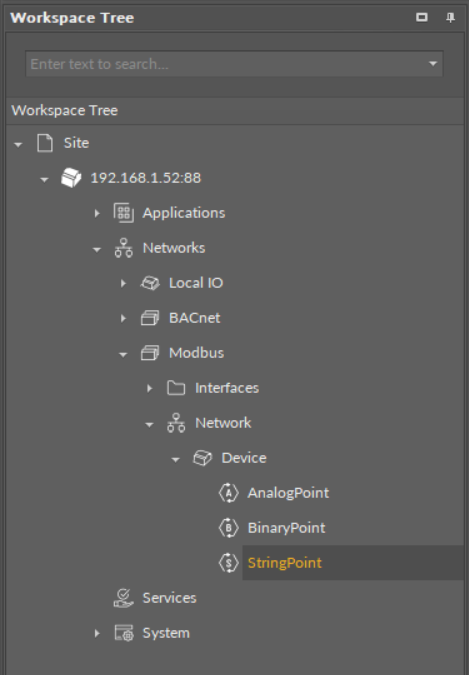The StringPoint component is a network point class component, which is designed to work with the iSMA-B-LP room panel, and it allows to write values to registers displaying texts on the room panel's LCD display. The text sent to the room panel is defined in the StringPoint with the Set action, and it is always limited to 4 ASCII characters (any character entered over the 4th character is ignored and not displayed).
Note: Before using the component, make sure that its register address is assigned and its Status is OK.

The StringPoint component
Slots

The StringPoint component slots
The StringPoint component has the following slots:
-
Status: indicates the current status of the component; if the component works properly, its status is OK. The component becomes Disabled, once the Enabled slot is in false. The component's status is Fault, once the Address slot is null. If there is no response from the addressed point, the component goes into the Down status.Available information: Disabled, Fault, Down, OK.
-
Reference: a special slot allowing to connect network point class components with Data Point class components. It allows to transfer the Out slot value along with the component's status.
Note: Reference links from Data Points to network points also transfer values in the opposite direction, in a link-back-from process: having received a value by the Reference link, the network point transfers it back to the Data Point to whichever input priority from 1 to 16 is set in the network point.
-
Description: an additional detailed information about a component that may be freely described by the user; the description may contain individual coding, defined in the user's system documentation, meter's or sensor's location, or any other information the user finds applicable.
Note: The description is effectively added only if the point allows it–the description is not added internally in the RAC18-IP for the remote point, but it is sent directly to the point.
-
InputPriority: allows to indicate the input number in the Data Point, which the network point class component's output value is sent to, in case the network point detects the change on its Out slot; none priority is set by default.Available settings: none, 1-16.
-
Polling Mode: allows to set the frequency of sending polling requests for the point's value to remote devices—by default, the polling mode is set to normal;Available settings: fast, normal, slow;
-
Enabled: change of the slot's value enables or disables the component.Available settings: true (enabled), false (disabled).
Note: If the Enabled slot is in false (meaning the component is disabled), the Status slot becomes Disabled.
-
Out: a real value read from or written to the register of the remote device.
Note: If the component's Status is fault (e.g., an invalid value in the Address slot), the Out value is null.
-
Units: defines a unit of the Out slot value; no unit is set by default;
-
Scale: sets a fixed scaling factor for output linearization; the written value is calculated according to the inverse linear function formula (x=(y-b)/a), and the calculated value is read to the Out slot according to the linear function (y=ax+b); the Scale slot sets the a value of the formula; incorrect scaling of the results in the calculated value (exceeding the available range for the device, e.g., 0-10 V), results in indicating a different value on the input and on the Out slot. If the scaling is correct, the values are identical;
-
Offset: sets a fixed offset value to the output value; the value is calculated according to the inverse linear function formula (x=(y-b)/a) and read to the Out slot according to the linear function (y=ax+b); the Offset slot sets the b value of the formula; incorrect scaling of the results in the calculated value (exceeding the available range for the device, e.g., 0-10 V), results in indicating a different value on the input and on the Out slot. If the scaling is correct, the values are identical;
-
Address: allows setting an address of the Modbus register in the remote device; once the component has been added, the slot's default value is null—for the component to operate properly, the unique address value must be set in this slot.
Note: The Modbus register address is set in decimal format.
-
Text: displays the text, which is sent to the room panel's Modbus register defined in the Address slot. The text value is entered with the Set action, and it is transformed to the analog value according to the ASCII code for each character. The text value is always limited to 4 characters. The text can either be entered in lower case characters, or capital letters—the room panel adjusts characters in case sensitive registers.
Modbus Registers for LCD Display
The Address slot in the StringPoint defines the Modbus register, which receives the text value to display on the room panel's LCD display. The Address slot receives the decimal address of the LP Modbus register. The list of Modbus registers, which can be addressed in the StringPoint is available here: StringPoint Modbus Registers.
Find out more about the Reference linking.
Action
-
Set: allows to manually enter the text, which is sent to the room panel; it allows to change the room panel's text registers directly from the device.
